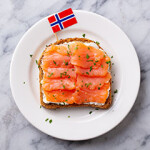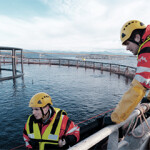Alaska seafood industry rides stormy pandemic markets

Dizzying swings in markets and consumer trends touched off by the coronavirus pandemic have forced the Alaska seafood industry to rethink its entire business model, from marketing to distribution to product mix.
Last week, professionals from across the industry and around the world convened on Zoom for a virtual installation of All Hands on Deck, an annual conference hosted by the Alaska Seafood Marketing Institute (ASMI). Experts discussed the quick pivot the Alaska seafood industry made as foodservice industry fell off a cliff while grocery sales and e-commerce surged following the outbreak of the coronavirus inside the United States.
Through the spring and summer, consumers scooped up more frozen seafood, and demand for shelf-stable products like canned and smoked fish rose. According to the U.S. Bureau of Economic Analysis, retail sales of seafood shot up 28 percent, significantly more than any other middle-of-the-plate protein.
Guy Pizzuti, the seafood category manager for Publix, said this was in part due to the industry’s experience with complex, mutable logistics.
“All the other proteins really struggled, but we’re in chaos every day. When you’re dealing with a wild-harvested product, you don’t know if it’s going to be there so you’re constantly having to adjust,” Pizzuti said.
Apart from channeling seafood into retail stores, the industry also saw swift growth in online sales. McKinley Research consultant Dan Lesh said while e-commerce still only makes up 5 percent of seafood sales, it has grown 100 percent since the pandemic began, and is demanding increased attention from distributors.
And with seafood out of restaurants and into homes, Megan Rider, ASMI’s domestic marketing director, said her team worked hard to help quarantined consumers feel comfortable cooking their own seafood. ASMI focused on simple meals with few ingredients that busy parents, saddled with raising kids and working from home, could prepare. Convenient cold seafood options and lunches were a focus as well.
Greg Jeffers, the director of the McDonald’s business unit for Gorton’s, the largest frozen seafood retailer in the U.S., confirmed the frozen sector is seeing a flood of new consumers looking for healthy, sustainable proteins they can stockpile in their freezers and prepare at home. The industry must figure out how to keep these new consumers post-pandemic, he said.
“[It’s] a massive opportunity,” Jeffers said. “When I see an opportunity for Alaska seafood, it’s connecting with these new consumers that have just come in the door. U.S. consumption of seafood over the last 10 years has been really flat, now we have an opportunity to take advantage of people how have just stepped into seafood.”
Dan Aherne, who runs Chessington, United Kingdom-based New England Seafood, is among industry experts banging the drum for wild seafood’s health benefits, in particular wild salmon’s high levels of vitamin D, which research indicates can combat the effects of COVID-19.
“I annoy my team twice a week with emails reminding them that wild Alaska sockeye salmon is one of the highest naturally occurring sources of vitamin D of any food type,” said Aherne, whose USD 200 million company (EUR 169 million) sells predominantly Alaska sockeye salmon in the U.K. and was recently acquired by Sealaska.
And while the pandemic has put added pressure on the market, industry insiders said several other factors complicated wild seafood sales, like tariffs, low catch volumes, and depressed farmed salmon prices, which were down to around USD 4.00 (EUR 3.37) from USD 6.00 (EUR 5.06) at the beginning of the year, according to Urner Barry.
Aherne said low prices for farmed fillets increases the pressure on sellers of wild-caught Alaska salmon to differentiate the product to consumers.
“Alaska salmon has largely held its value, which is why the quality needs to stay high to justify that premium,” Aherne said.
Or the industry needs to find a way to bring the price down, according to Ron Christianson, the vice president of retail sales for Ocean Beauty. This effort, along with a separate quandary facing companies of what to do with smaller fish, has led to innovative ideas like increasing sales of whole or H&G fish directly to consumers, Christianson said.
“We are looking for affordable options for domestic salmon sales where possible,” he said. “There’s been developments for selling whole fish to a variety of markets because of different cooking techniques as well as certain cooking trends.”
Christianson said while processors may have sold all their fish, there are concerns moving wild Alaska seafood out of distributors’ freezers, particularly in regard to expensive sockeye salmon.
“It is sitting in inventories and we’re competing against really affordable farmed fish right now, and coming up with any options that helps us compete from a price standpoint is going to be a real struggle,” Christianson said.
Photo courtesy of Bristol Bay Regional Seafood Development Association






Share